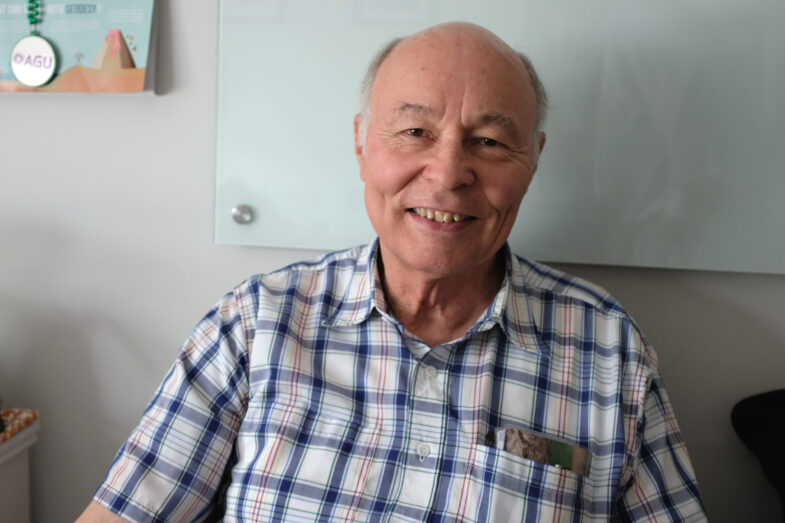
Remembering Haystack former leader and research scientist Alan Whitney
Dr. Alan R. Whitney, former principal research scientist, associate director, and interim director, died on September 28 at age 81.
Whitney was a key contributor to the accomplishments and reputation of Haystack Observatory, having led the development of innovative technologies to advance the powerful radio science technique of Very Long Baseline Interferometry (VLBI). He ascended to the rank of MIT Principal Research Scientist, served for many years as Associate Director of the Observatory, and in 2007–2008 took the reins as interim Observatory Director. In 2011, he was awarded an MIT Excellence award.
From an early age, Whitney displayed extraordinary talent. Raised in Wyoming, as a high schooler he won the State Science Fair in 1962 by building a satellite telemetry receiver, which he designed and built from transistors and other discrete components in a barn on the family’s dairy farm. He enrolled at MIT and completed a five-year Master’s degree via a cooperative internship program with Bell Laboratories, subsequently earning his PhD in Electrical Engineering.
Haystack Director Phil Erickson said, “Alan’s personality and enthusiasm were infectious, and his work represented the best ideals of the Haystack and MIT research enterprise—innovative, curious, and exploring the frontiers of basic and applied science and technology.”
In the late 1960s, as part of his PhD work he was heavily involved in the pioneering development of VLBI, an extraordinary technique that yielded direct measurements of continental drift and information on distant radio sources at unprecedented angular resolution. A landmark paper led by Whitney demonstrated the presence of apparent superluminal (faster than light) motion of radio sources, which was explained as highly relativistic motion aligned toward the Earth. He spent the rest of his long and productive career at Haystack, pushing forward VLBI technology to ever greater heights and ever more impactful scientific capabilities.
“Alan was a technology pillar, a stalwart builder and worldwide ambassador of Haystack, and a leading figure of the VLBI geodetic community who inspired generations of scientists and engineers,” said Pedro Elosegui, leader of the Haystack geodesy group. “He contributed fundamentally to the vision and design of the VLBI Geodetic Observing System (VGOS), outlining a path to a next-generation VLBI system with unprecedented new capabilities to address emerging space geodesy science needs such as global sea-level rise.”
The early days of VLBI demanded heroic and grueling efforts, traveling the world with exotic devices in hand-carried luggage, mounting and dismounting thousands of magnetic tapes every couple of minutes for hours on end, troubleshooting complex and sensitive instrumentation, and writing highly specialized software for the mainframe computers of the day. Whitney was fully engaged on all these fronts. By the early 1980s, the Mark III (MkIII) recording and correlation systems, whose development was led by Whitney, were established as the state of the art in VLBI technology and a standard around which the global VLBI community coalesced.
Whitney later led the transition to VLBI disk-based recording. Specialized and robust Mark V (MkV) systems optimized for shipping logistics and handling were transferred to industry for commercialization, leading once again to widespread global adoption of Haystack-developed VLBI technology. Consistently across all these developments, Whitney identified and exploited the most relevant and practical emerging technologies for the Haystack VLBI mission in hardware, software, and computing infrastructure.
In the latter part of his illustrious career, Whitney continued to innovate, pushing the technical boundaries of VLBI. A key advance was the Mark 6 (Mk6) recording system, capable of yet faster recording, higher sensitivity, and more robustness. The Mk6 recorders’ essential capability allowed the creation of the Event Horizon Telescope (EHT), which famously yielded the first image of the shadow of a black hole. Mk6 recorders are now used to routinely record data roughly 100,000 times faster than the computer tapes used at the start of his career.
As a senior technical and scientific leader, Whitney provided broad leadership and consultation to Haystack, and worked on a number of projects outside of the VLBI world. He served as interim Haystack director, from January 2007 until a permanent director was appointed in September 2008. He also engaged with the development project for the international Murchison Widefield Array (MWA) in Australia, focused on frontier research studying early universe development. Whitney assumed the role of MWA project director from 2008 until groups in Australia took over the construction phase of the project a few years later. Until his full retirement in 2012, Whitney continued to provide invaluable technical insights and support at Haystack, and was a trusted and wise counsel to the Haystack Director’s Office. In 2020, Whitney was a co-recipient of the 2020 Breakthrough Prize in Fundamental Physics awarded to the Event Horizon Telescope Collaboration.
Alan Whitney was a top-notch technologist with a broad perspective that allowed him to guide Haystack to decades of seminal leadership in the development and refinement of the VLBI technique. His dedication at MIT to the Observatory, its people, and its mission were a source of inspiration to many at Haystack and well beyond. He was widely admired for the clarity of his thought, the sharpness of his intellect, and his genial and friendly nature. His numerous local, national, and global colleagues will feel his absence.